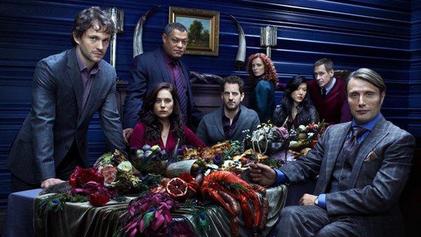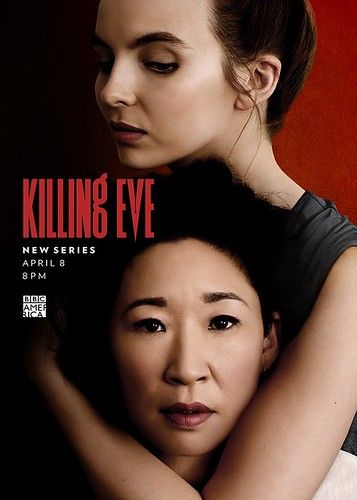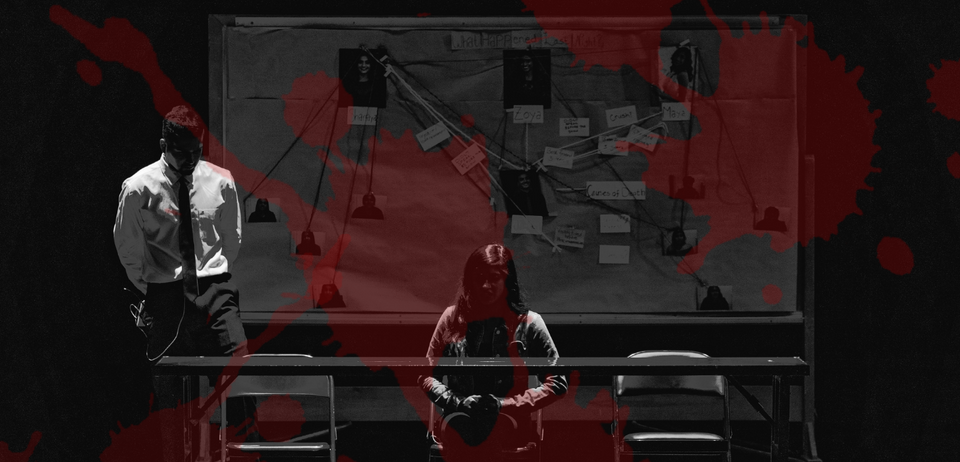Film Noir is boxed into a period from roughly from the 1920s to the 1950s. In particular, after World War II, French cinephiles and critics analyzed the American films that came out during the war. But I argue that there are many queer coded television shows that have come out in the last ten years that follow all the tropes that are attributed to noir. They are not considered a part of the genre by critics because the rules of the genre are very rigid. However, as noir exists in the ambiguous morals and darkness of the time, why should it not expand to include the moral ambiguity of today? I believe Hannibal and Killing Eve are great examples of shows that could be considered noir. They fit all the archetypes even though they are not from the specific time period. We should expand the concept of noir and not exclude them from the conversation.
There are certain character tropes that often appear in noir that are present in Hannibal and Killing Eve. The most notable characters that appear in noir are the hard boiled protagonist, the detective, the amnesiac, and the femme fatale. These characters represent the social climate of America during the pre and post WWII years. The ambiguous morals and fear of powerful and independent women were reflective of what was the general American ethos.

Hannibal is a psychological thriller Television show based on the trilogy novels by Thomas Harris. It follows Quantico Professor Will Graham as he is pulled into active field investigation by Jack Crawford, Head of the Behavioral Sciences unit at the FBI. Will is a desirable asset to Crawford as he has what is described as perfect empathy caused by a surplus of mirror neurons. Meaning he can almost flawlessly get into a killer’s head and not only reconstruct the crime but psychoanalyze them by just seeing a crime scene. However, he sees it through the eyes and emotions of the killer. He feels little to nothing for the victim and often feels the killer’s pleasure. It is well known that Will is an anomaly that is not completely mentally stable. Jack Crawford bypasses an official psychological evaluation, knowing that Will would fail, by hiring a psychiatrist under the table instead of using Alana Bloom, a psychologist that often works with the BUA. Alana, however, hates the idea of Will being in the field; because she is friends with Will she is not allowed to conduct the evaluation herself. This puts Hannibal Lecter and Will Graham into each others lives.
Hannibal Lecter is a Lithuanian born aristocrat that uses his money, affluence, and intelligence to distract from the fact that he is the most notorious serial killer in Baltimore; The Chesapeake Ripper. He is the Femme Fatale of the show, more accurately, the Homme Fatal. While his sexuality is never explicitly mentioned, he does admit to being interested in and then in love with Will. At first he is only interested in Will’s potential for violence, as he is aware of Will’s ability to empathize with serial killers. Slowly, as they began to know each other, Hannibal’s interest turns to killing with Will. In a later season, they are dubbed the ‘Murder Husbands’ much to Hannibal's pleasure and Will’s dismay. Hannibal uses sex not for pleasure but as a means to an end. He sleeps with Alana when he is suspected to be the Chesapeake Ripper, as he perfectly fits the profile, so he can use their coupling as an alibi. He continues this affair, to not only make Will jealous, but also to deter Alana’s romantic and sexual interest in Will. He also uses her as an advocate when Will suspects Hannibal of being a killer. Hannibal as a Femme Fatale is not entirely out of the realm of noir as stated in Homesexuality and Film Noir by Richard Dryer. "What are these gay characters doing in film noir? In the first instance, they are a further amplification of images of sexual "decadence" and "perversion""(Dryer). In Women in Noir by Yvonne Tasker and Helen Hanson: “For many critics this ambivalence about women’s place can be attributed in part to the social turbulence of World War II and its aftermath.”(Tasker 354). So mixing the two character types in turn represents the ambivalence of the LGBT+ community in American society and the still prevalent stereotypes that exist for homosexual men.
The protagonist of a noir is usually a proletarian male that can be described as rough and street smart. While he has settled into a life of academia, his story is that of a nomad - his father repaired boats and had to go wherever the money went. Will continues this blue collar lifestyle by becoming a police officer until he is shot in the line of duty. He still chooses to live far below his means as he doesn’t like the attention and is far more comfortable in his small house in the woods with his seven dogs. Will is intellectual but most of his accomplishments are completed through instinct and ‘gut feelings’ that are usually proven to be correct.
Will also fits the archetype of the amnesiac, who through memory loss allows for the mediation of existential subjects. Throughout the first two seasons Will has undiagnosed encephalitis, an autoimmune infection that causes inflammation in the brain. It’s symptoms include fever, auditory and visual hallucinations, sleep walking, seizures, and blackouts. As Hannibal is a former surgeon, he recognizes the symptoms and uses Will’s illness to his advantage. As Will’s hallucinations uncloud the murderers with whom he empathizes, Hannibal begins to validate Will’s more violent thoughts and fantasies resulting in Will’s confusion as to whether these thoughts are his or if they belong to others and if those thoughts are really morally wrong.
Will’s boss Jack Crawford is a perfect example of a detective archetype. He is only concerned with solving cases and saving lives. He has no qualms disregarding procedures to catch a killer, including putting a trainee on the field and working with a morally corrupt gossip journalist. Little else is known about his character that doesn’t revolve around his work however given that the show is focused on Hannibal and Will’s relationship, Jack mostly acts as an obstacle and a symbol of hard justice.
Aesthetically the show follows a modern approach to classic noir. Low key lighting with high shadow contrast is often used to highlight the ‘dark’ nature of the genre. Hannibal modernizes this by using lights in different colors such as reds and greens to show jarring juxtaposition. As Hannibal is a consultant for the FBI, and also a cannibalistic serial killer, scenes of gore and mutilation are usually put in the same vein as food and eating. The constant comparison of the lavish lifestyle of Hannibal with the modest lifestyle of Will is also shown to emphasize their difference in superficial aspects but the similarity in their mindsets. The show also likes wordplay choosing to juxtapose a shot of handcuffs with cufflinks, showing that no matter what Hannibal will usually come out of a situation clean and free while Will is the one left to face the consequences. Hannibal and Killing Eve almost identical aesthetics with the only differences being that Killing Eve is more feminine and less blatantly gore.
Killing Eve is a British dark comedy television series based on the novel Villanelle by Luke Jennings. The show starts with Eve Polastri, a Korean-American expat living in England with her husband Niko Polastri. She’s bored with her safe office job at MI5 and becomes increasingly obsessed with the idea of female assassins, especially one that she believes is behind a string of high profile assassinations that have been occurring throughout Europe. Eve is determined and fascinated by female assassins to the point of disregarding orders to talk to a key witness which results in her getting fired. Luckily she is quickly picked up by the famous MI6 director and former field agent Carolyn Martens. She’s given chance after chance because she has a gut feeling and instinct that cannot be taught.
Villanelle is a Russian assassin that works for a secret organization known as The Twelve. She frankly doesn’t care about their motives as long as she can ‘play’ and make a flamboyant show of it. The first time we see Villanelle kill is in Tuscany. She sneaks into an Italian mafia boss’ house and wanders into his bedroom where she finds his wife’s wardrobe. He is not at all suspicious of the woman that he finds lounging in his room as he believes her to be a sex worker given to him as a birthday gift. She keeps the act long enough to stab him in the eye with a hairpin. She is also not above acting the part of an innocent English girl when she needs to get out of trouble.
The Detective archetype is actually Eve’s boss in MI6, Carolyn Martens. Unlike Eve, Caroline is not blinded by interest and will to anything to get to the bottom of The Twelve. She is described as the perfect spy and she has the resume to prove it. Caroline is able to disregard her emotions and relationships to get information. She is what Eve could be if she wasn’t so emotional and reckless.
But why make it queer? This could be attributed to the need for representation or the need to manipulate classics to create something familiar yet fresh. As “Film noir seems to have been a creative release for everyone involved. It gave artists a chance to work with previously forbidden themes,”(Schrader 62) LGBTQ+ subjects unfortunately are still considered somewhat taboo; even with filmmaker creatively getting around sensors, queer characters have not often been the main focus. “[Noir] exists in response to a certain mood at large in this particular time and place.”(Borde and Chaumeton 19)

In recent years, the queer identity and its connection to morality has been brought into mainstream socio-political thought. It is to be expected that art will reflect that and connect it the angst and uncertainty that exists in noir. So if Noir is a direct response to the ambiguity and moral turmoil of society, it cannot exist in only one decade as this is a problem every society has faced from the beginning of recorded history till today.

Anne-Tetchly Charles is New York Based multimedia creator. She is pursuing a Cinema Studies Major and double minor in Creative writing and fine art. She is passionate about black female representation in media and hopes to create content that reflects that.

